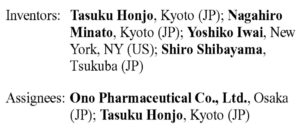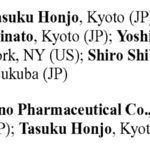前回記事「抗PD-1抗体に関する本庶特許の発明者を巡る米国での裁判、そして日本・・・」

 2020年7月14日、CAFCは、抗PD-1抗体等に関する6つの米国特許(所謂「本庶特許」)の共同発明者として本庶氏とともに研究に貢献したWood氏とダナファーバーがん研究所のFreeman氏の2名が追加されるべきであるとした米国マサチューセッツ州連邦地裁判決を支持する判決を下しました(2020.07.14 DANA-FARBER CANCER INSTITUTE v. ONO PHARMACEUTICAL CO., LTD. CAFC No.2019-2050)。
2020年7月14日、CAFCは、抗PD-1抗体等に関する6つの米国特許(所謂「本庶特許」)の共同発明者として本庶氏とともに研究に貢献したWood氏とダナファーバーがん研究所のFreeman氏の2名が追加されるべきであるとした米国マサチューセッツ州連邦地裁判決を支持する判決を下しました(2020.07.14 DANA-FARBER CANCER INSTITUTE v. ONO PHARMACEUTICAL CO., LTD. CAFC No.2019-2050)。
In 1992, Dr. Honjo discovered PD-1 and theorized that it played a role in inhibiting the immune response. But despite having this knowledge, Dr. Honjo still enlisted collaboration with the Genetics Institute to search for ligands for PD-1. Even under Ono’s view of the facts, knowledge of PD-1 was itself insufficient for Dr. Honjo to conceive of the method claimed in the ’474 patent.
It is clear based on the record that Drs. Freeman and Wood both contributed to conception of the ’474 patent. Dr. Freeman connected the 292 sequence to PD-1 and directed important immunohistochemistry experiments revealing that several types of tumors express PD-L1. Dr. Wood provided Dr. Honjo with the first confirmation that the PD1/PD-L1 interaction was inhibitory, supported by experimental data. Drs. Freeman and Wood’s work on PD-L1, Dr. Wood’s discovery that the PD-1/PD-L1 interaction inhibits the immune response, and Dr. Freeman’s discovery of PD-L1 expression by human tumors were significant building blocks upon which the ’474 patent is built.
2020.07.14 DANA-FARBER CANCER INSTITUTE v. ONO PHARMACEUTICAL CO., LTD. CAFC No.2019-2050
原審である米国マサチューセッツ州連邦地裁判決に対して、小野薬品、本庶氏、ブリストル・マイヤーズ スクイブ社は控訴していました。原審関連記事は下記参照。


Freeman氏から本発明に関する権利および利益を譲り受けたダナファーバーがん研究所は、小野薬品およびブリストル・マイヤーズ スクイブ社が上記本庶特許の独占的所有者として競合他社に対して特許侵害訴訟を提起し、和解またはライセンス契約を締結したことで得たライセンス収入の一部の利益を受ける権利を有していると主張し、米国マサチューセッツ州連邦地裁に提訴しています(2020年6月19日に掲載された小野薬品の有価証券報告書(2020年3月期通期)より)。
CAFCが2名の発明者の追加を命じた第一審の判断を支持したことで、ダナファーバーがん研究所が米国では本庶特許の共有権利者として加わることになり、上記マサチューセッツ州連邦地裁で争われている事件の判断に影響するだけでなく、他の国(日本)にも飛び火する可能性が大いにでてきました。

次回記事「抗PD-1抗体に関する本庶特許の発明者を巡る米国での裁判、そして日本・・・(3)」





コメント